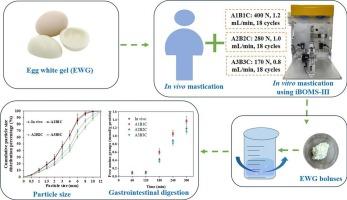Unrevealing the impact of impaired mastication capacity on the kinetics of proteolysis of egg white gel boluses formed using the bio-inspired oral mastication system (iBOMS-III)
IF 8
1区 农林科学
Q1 FOOD SCIENCE & TECHNOLOGY
引用次数: 0
Abstract
Understanding how oral mastication influences the digestion of food is essential for designing diets and products suited to populations with varying chewing abilities. In this study, we used an innovative in vitro bionic oral mastication system (iBOMS-III) to replicate different chewing conditions by adjusting mastication force and saliva flow rate. Egg white gel (EWG) was used as a model protein-rich food. Comparative analyses showed that the iBOMS-III operating under standard adult-like conditions (A1B1C: 400 N force, 1.2 mL/min saliva flow) produced EWG boluses with a median particle size of 3.17 mm, closely matching the in vivo median of 3.29 mm. Boluses formed under reduced mastication conditions (A2B2C and A3B3C) had larger particle sizes of 4.16 mm and 4.83 mm, respectively. Subsequent in vitro digestion revealed that the free amino group release after gastric and intestinal phases was significantly higher for A1B1C (1.36 mmol/g protein) and in vivo (1.38 mmol/g protein) boluses compared to A2B2C (1.18 mmol/g) and A3B3C (1.06 mmol/g) (p < 0.05). Rheological analysis confirmed that boluses produced with lower mastication force and saliva flow showed higher hardness and viscoelastic moduli, making them more resistant to enzymatic breakdown. These findings confirm that iBOMS-III can realistically mimic human mastication and quantify its downstream effects on digestion. The findings provide mechanistic evidence that chewing performance directly influences protein digestibility, offering insights for the development of foods tailored to older adults and individuals with impaired oral function.

未揭示咀嚼能力受损对使用仿生口腔咀嚼系统(ioms - iii)形成的蛋清凝胶丸的蛋白质水解动力学的影响
了解口腔咀嚼如何影响食物的消化对于设计适合不同咀嚼能力人群的饮食和产品是必不可少的。在这项研究中,我们使用一种创新的体外仿生口腔咀嚼系统(iBOMS-III),通过调节咀嚼力和唾液流速来复制不同的咀嚼状态。以蛋清凝胶(EWG)为模型富蛋白食品。对比分析表明,ioms - iii在标准成人样条件下(A1B1C: 400 N力,1.2 mL/min唾液流量)产生的EWG丸的中位粒径为3.17 mm,与体内中位粒径3.29 mm非常接近。还原咀嚼条件下形成的微丸(A2B2C和A3B3C)粒径较大,分别为4.16 mm和4.83 mm。体外消化结果显示,与A2B2C (1.18 mmol/g)和A3B3C (1.06 mmol/g)相比,A1B1C (1.36 mmol/g蛋白质)和体内(1.38 mmol/g蛋白质)在胃期和肠期后的游离氨基释放量显著高于A2B2C (1.36 mmol/g)和A3B3C (1.06 mmol/g) (p < 0.05)。流变学分析证实,咀嚼力和唾液流量较低的丸剂具有较高的硬度和粘弹性模量,使其更耐酶解。这些发现证实了ioms - iii可以真实地模拟人类咀嚼,并量化其对消化的下游影响。研究结果提供了咀嚼性能直接影响蛋白质消化率的机制证据,为开发适合老年人和口腔功能受损个体的食物提供了见解。
本文章由计算机程序翻译,如有差异,请以英文原文为准。
求助全文
约1分钟内获得全文
求助全文
来源期刊

Food Research International
工程技术-食品科技
CiteScore
12.50
自引率
7.40%
发文量
1183
审稿时长
79 days
期刊介绍:
Food Research International serves as a rapid dissemination platform for significant and impactful research in food science, technology, engineering, and nutrition. The journal focuses on publishing novel, high-quality, and high-impact review papers, original research papers, and letters to the editors across various disciplines in the science and technology of food. Additionally, it follows a policy of publishing special issues on topical and emergent subjects in food research or related areas. Selected, peer-reviewed papers from scientific meetings, workshops, and conferences on the science, technology, and engineering of foods are also featured in special issues.
 求助内容:
求助内容: 应助结果提醒方式:
应助结果提醒方式:


